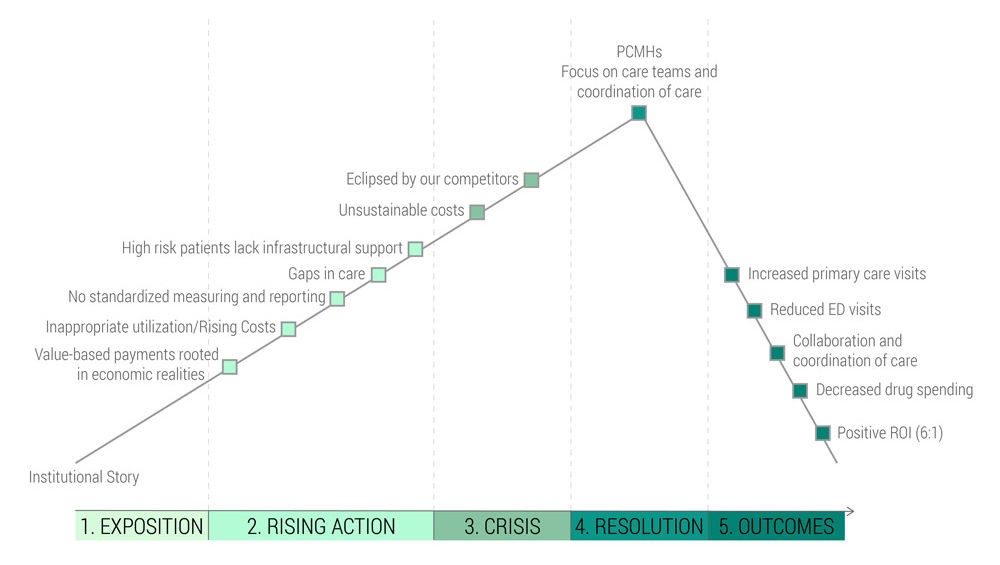Dear Effective Communicator:
Help!
I’ve been told repeatedly to tell a story when I’m presenting, but I don’t get it. I promise it isn’t for lack of trying. During a recent presentation, I started off with a story about a time when my team worked together to decrease clinic wait times by huddling for 5 minutes every morning. I didn’t have any time left for my presentation by the time I finished my story. What am I doing wrong?
Sincerely,
Sorry Storyteller
Dear Sorry Storyteller:
Why Your Brain Loves Good Storytelling
This HBR article explains how stories change our attitudes, beliefs, and behaviors.
he difficulty with telling stories is that we overthink it. The word story can mean different things. The Effective Communicator likes to make a distinction between Story-with-a-capital-S and story-with-a-little-s. For the sake of clarity, we’ll refer to the former as narrative, and the latter as anecdote—it’s not a perfect comparison, but it’ll get the job done.
When people say, “Tell a story,” what they mean is, “Craft your presentation as a narrative.” By all means, add a personal anecdote to connect with your audience, but try thinking of your whole presentation as a story.
Before writing came along, narratives were the way we stored and shared information. They’ve been helping us make sense of this chaotic world ever since. According to the communication theorist Walter Fisher, narratives provide order to our lives by helping us connect different experiences into a coherent whole. Narratives tie up loose ends.
Fisher calls us “story-telling animals.” This is where the overthinking part comes in: since story-telling is in our evolutionary make-up, it comes naturally. The key is to adjust your perspective to take advantage of this natural ability.
Think of it this way: Your presentation is the story . We’ll show you how.
Narratives have a structure that you can map—and since you can map it, you can use that same structure to create it. The Oregonian’s former writing coach, Jack Hart, provides a useful model for thinking about how we can structure a narrative. Hart’s model is directed at journalists, so we’ve modified it for presenters.
Narrative Arc Example: Patient-Centered Medical Home

The narrative model includes five phases. Here is an example of a presentation's topics (in this case, why patient-centered medical homes are a good idea) labeled in the appropriate phase. Adapted from Jack Hart's Storycraft.
The five essential components of narrative arc
Narratives have five essential components: exposition, rising action, crisis, resolution, and outcome. You have the first three in your question:
More from the Effective Communicator
| Your question (an incomplete arc) | Narrative component |
|---|---|
| I’ve been told over-and-over to tell a story when I’m presenting, but I don’t get it. | Exposition (think of this as setting the scene, providing the context) |
| During a recent presentation, I started off with a story about a time when my team worked together to decrease wait times... | Rising Action (you’re setting up the plot, preparing your listener for what comes next) |
| By the time I finished my story about huddles, I didn’t have any time left for my presentation. | Crisis (there’s a clear problem that needs a solution) |
Your narrative is incomplete. But not by much! (And it’s a good example of how narratives are not always discrete. A narrative crosses time and space. For example, your question is part of the narrative of this blog post.) You started it, but you needed the Effective Communicator to finish it.
| Your question (a complete arc!) | Narrative component |
|---|---|
| So I reached out to the Effective Communicator to figure out what I was doing wrong. The Effective Communicator told me to think more broadly about stories by thinking of them as narratives. | Resolution (the solution to the problem) |
| Since narratives draw on the way humans give and receive information, they can be an effective tool when presenting. |
Outcome (the conclusion) |
*Adapted from Jack Hart’s Storycraft: The Complete Guide to Writing Narrative Nonfiction
Turing a presentation into a narrative is difficult, but understanding how you’re already doing it can make it easier. By combining relevant anecdotes with appropriate explanations, your audience will get your point, and, more importantly, act on it.
Sincerely,
The Effective Communicator
The Effective Communicator is Isaac Holyoak. Isaac is a contributing editor for Accelerate and leads communication for University of Utah Health Medical Group. He received a Master's in rhetoric from the Brian Lamb School of Communication at Purdue University and taught speech, argumentation, and debate to undergraduates in Indiana and Texas in his pre-health care life.
Isaac Holyoak
Exceptional care only happens with an engaged team. Jared Wrigley should know: he has led three diverse teams at U of U Health—first, Westridge Health Center, and now, South Jordan’s primary care team and Parkway Health Center. Here are three effective ways he engages everyone on the team.
Expert communicators Emily Izzo and Bridgette Maitre share how to ask open-ended questions to encourage conversation and promote meaningful connection.
Department of Surgery collaborators Courtney Lauer, Erin Heath, and Christina Choate share their process for establishing a culture of collaboration that facilitates communication across teams, fosters shared goals, and creates an atmosphere where failure is an opportunity to learn.

